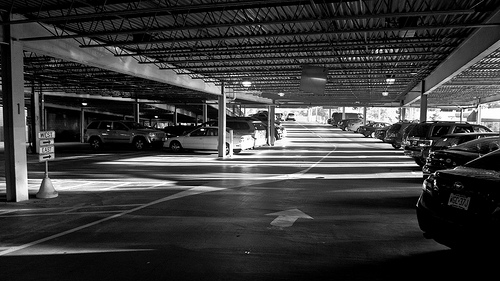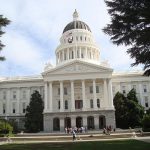Parking report: L.A. needs infill (badly)
How can parking impact traffic in one of the country’s most notoriously congestion-plagued cities? Plenty of cities maintain minimum parking requirements, yet, as certain researchers are pointing out, there is lacking data on how much parking infrastructure has expanded. In the recent study, “Parking Infrastructure: A Constraint on or Opportunity for Urban Redevelopment? A Study of Los Angeles County Parking Supply and Growth,” these researchers chart and examine just how parking expanded in Los Angeles County between 1900 and 2010.

Image by Jim Penucci.
Two compelling findings: Since 1975 there has been nearly one off-street parking space for every auto in Los Angeles, and nearly 15% of the county is devoted to providing a space for a vehicle.
The study also delves into how minimum parking requirements are likely to boost car use, despite cities’ best efforts, such as movements to tackle traffic problems by encouraging transit use, cycling, and walking, like Transportation Alternatives.
As the researchers note, growth in the number of spaces peaked between 1950-1980, with the rate slowing ever since. Plus, from 1950-1975, the county offered more spaces than cars, and, since then, “the ratio of residential off-street parking spaces to automobiles has hovered around unity.” Still, the new growth in spaces is found outside of the city center and is related to increased car use and ownership.
Los Angeles County is just about the perfect county for this type of research; with 10 million residents (in 2010), 4,700 square miles and a great number of decentralized communities located along the highway, the city has grown in large part thanks to the car. The county’s parking history is an intriguing one: In the 1930s, L.A. County implemented minimum parking requirements in zoning ordinances to combat traffic congestion; the ordinances in turn demanded new development or redevelopment projects to provide an allotted amounts of parking relevant to size and activity. “This was considered an effective way for cities to keep vehicles off the road, reduce illegal parking, avoid the spillover of cars into adjacent residential neighborhoods, and prevent cruising for vacant street spaces,” write the study authors.
L.A. County also offers more, and more complimentary, parking than many cities, with infrastructure “scattered” throughout the region via on-street spots as well as off-street lots and parking structures. This abundance of parking poses a challenge for those seeking to reform the way Angelenos navigate their city, and their lives.
Write the authors, “Within L.A. County we see significant variations in the number of spaces and the density of parking spaces. There is abundant parking where high-quality transit exists, which is likely to work against transit, walking, and biking.” Mandatory parking requirements also increase the cost of housing, which means that, as the researchers share, urban planners need to factor in parking’s implications on affordable housing.
What’s the solution to promoting sustainable transit in a city seemingly built for and around cars? Via a detailed analysis of the way parking has evolved over time in the County, the researchers demonstrate that urban planners and policymakers alike should “consider how the growth of parking infrastructure leads to greater automobility, develop new approaches to parking mandates including adopting maximum parking restrictions,” and address new growth through developing the city’s core, rather than through construction outside the city and on its peripheries, which increases car use.
Another approach: reform parking policies in particular locations, such as in high-density areas with “good public transit service” to encourage transit use, such as along the rail lines in L.A. County.
Want to learn more? Discover the full report here, and learn more about sustainable transportation initiatives here.

















